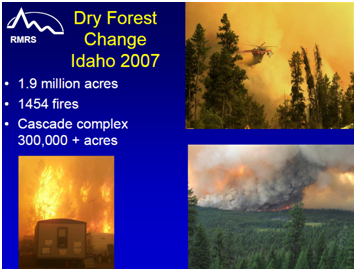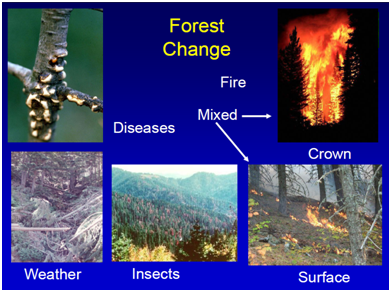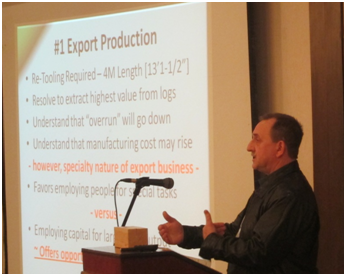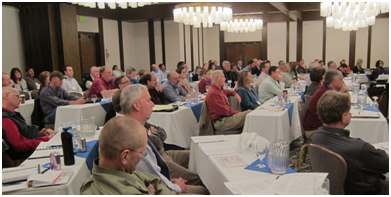

 Gary discusses Japanese
Gary discusses Japanese "Best Business Practices"
requirements.
 Day 2 is a packed house.
Day 2 is a packed house.
 Carlton Owen, President & CEO of U.S. Endowment for Forestry and Communities serving as Key Note speaker.
Carlton Owen, President & CEO of U.S. Endowment for Forestry and Communities serving as Key Note speaker.
 End of Conference
End of ConferenceDavid New moderates panel discussions.
Atica Events
January 31, 2012
The Idaho Forest Restoration Partnership invited Atica's Chairman and President to speak before an enthusiastic group of professional collaborative organizers, foresters, mill operators, etc. The conference - held in Boise, Idaho January 31 - February 1, 2012 was composed of a two day session.
Day 1
January 31 - "Making Collaborative Forest Restoration Work in Idaho."
The workshop was designed to offer practical tools for collaborators to use when working in forests that employ a mixed-severity fire regime, including those dominated by grand fir, western hemlock, western red cedar and subalpine fir. While these forest types comprise nearly 3/4 of all National Forests in Idaho, stakeholders struggle to reach consensus on management need and treatment methods.
Day 2
February 1 - "From Forest to Market - The Potential Roles of Biomass Energy and Wood Products in Supporting Forest Restoration"
Organized by the Society of American Foresters Snake River Chapter and Idaho Forest Restoration Partnership, the conference's speakers addressed methods to capture the economic value of the wood products produced by forest restoration. The target audience included land management agency staff, timber industry managers, local government and community representatives, and conservationists. Mr. Gary Cantrell - the second speaker on the agenda was asked to speak to the subject of "Realizing Export Lumber Opportunities - Strategic Timber Resource and Infrastructure Factors required for Asian Export Lumber manufacturing."
The Idaho Forest Restoration Partnership was formed to help strengthen collaborative forest restoration efforts across Idaho. The partners have agreed to support four principles in a common vision for our forests:
- Strategic forest restoration is essential to address the current challenges posed by uncharacteristic wildfire, insects, disease and climate change.
- Active management is needed to restore their resiliency.
- A healthy forest industry is a necessary part of a restoration to offset restoration costs and provide jobs.
- Collaborative groups can provide useful advice and recommendations through cooperation between citizens, including interest groups, elected officials, and public land managers.